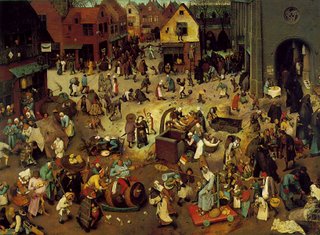
There is nothing comical beyond what is clearly human. A landscape can be beautiful, gracious, sublime, insignificant or ugly, but it can never be laughable. (Henri Bergson, Le Rire pp2-3).
In this unit we will look at some of the reasons why we laugh and the nature of comedy. We will begin with an analysis of a particular advertisement that showed on Prague TV in 2001.
We will do it from three points of view. First, using the ideas of French philosopher Henri Bergson, then of Russian philosopher and literary theorist Mikhail Bakhtin, and finally of biologist and literary theorist Joseph Meeker.
Click on the link below and watch the advertisement then answer the questions to check your comprehension. After that, in small groups compare your answers before attacking the discussion questions below.
Be Kind to Your Local Nazi - Youtube
Comprehension questions
What is the main point made by the advertisement?
Why, according to the adverisement, do nazis find it hard to make contact with other members of society?
What example of a social program is shown in the advertisement to help nazis integrate into society.
Discussion questions
Part A
1) Explain how the humour in the advertisement works.
2) Do you think the advertisement achieves its goals?
Part B
3) What do you think the reaction of the nazi community was in Prague after seeing this advertisement?
Click on the following link and listen to an item from Radio Praha (Radio Prague) in which the campaign methods and success are discussed. Answer the questions below after you have finished listening.
Anti-racist campaign considered a success
4) Where had the advertisement been shown prior to its screening in Prague?
5) What was the most important target group?
6) What was the strategy to dissuade them from joining neo-nazi groups?
7) What was the reaction from the fascist community?
8) The response of the target age group was positive. How did this age group respond to earlier anti-racist campaigns?
Answers will be in the next post.
Analysis
Part 1 - Henri Bergson's Le Rire
Read the following summary of French philosopher Henri Bergson's essay Le Rire, Written in 1940 'Le Rire' was an attempt to explain why people laugh. Once you have read the brief summary analyse the advertisement from Bergon's point of view.
Part 2 - Bakhtin's 'Carnival Laugh'
Read the following summary of Mikhail Bakhtin's understanding of the purpose of the carnival in Medieval and Renaissance Europe. Once you have done this analyse the advertisement from Bakhtin's point of view.
Bakhtin's Carnival Summary
Answers will be in the next post.
Part 3 - Joseph Meeker's Comic and Tragic Modes
In groups you will study sections of The Comic Mode by Joseph Meeker and answer questions.
I will give you your readings in class.
Tragic and Comic Modes Summary
For you to consider:
Try to explain the humour in this sketch
The fish slapping danceFurther Reading
Toby Graffit, Edith McMorran and Jane Taylor (2005) The Anatomy of Laughter. Legenda.
Return to Nature, Art & Language
© All Copyright, 2007, Ray Genet